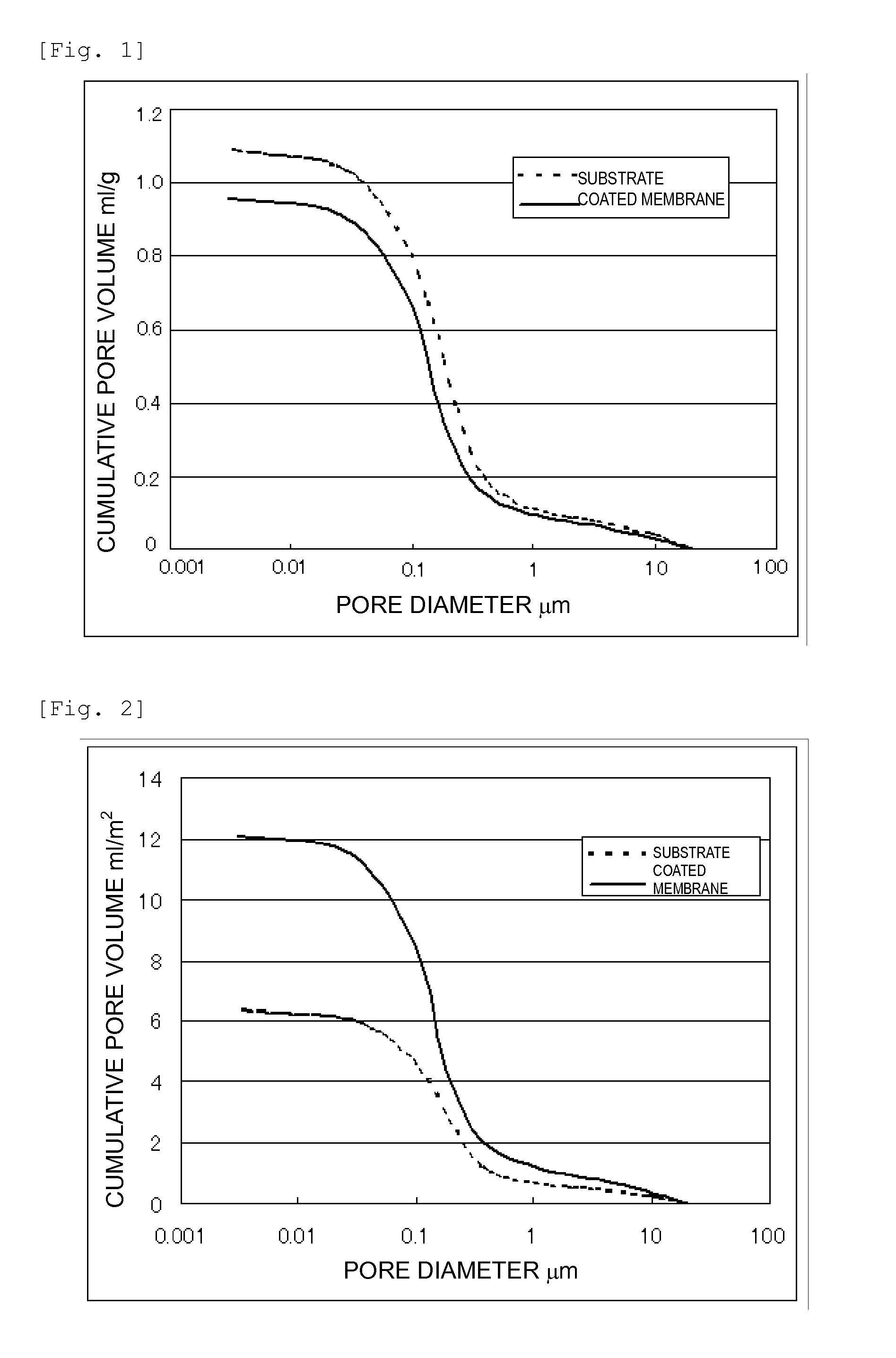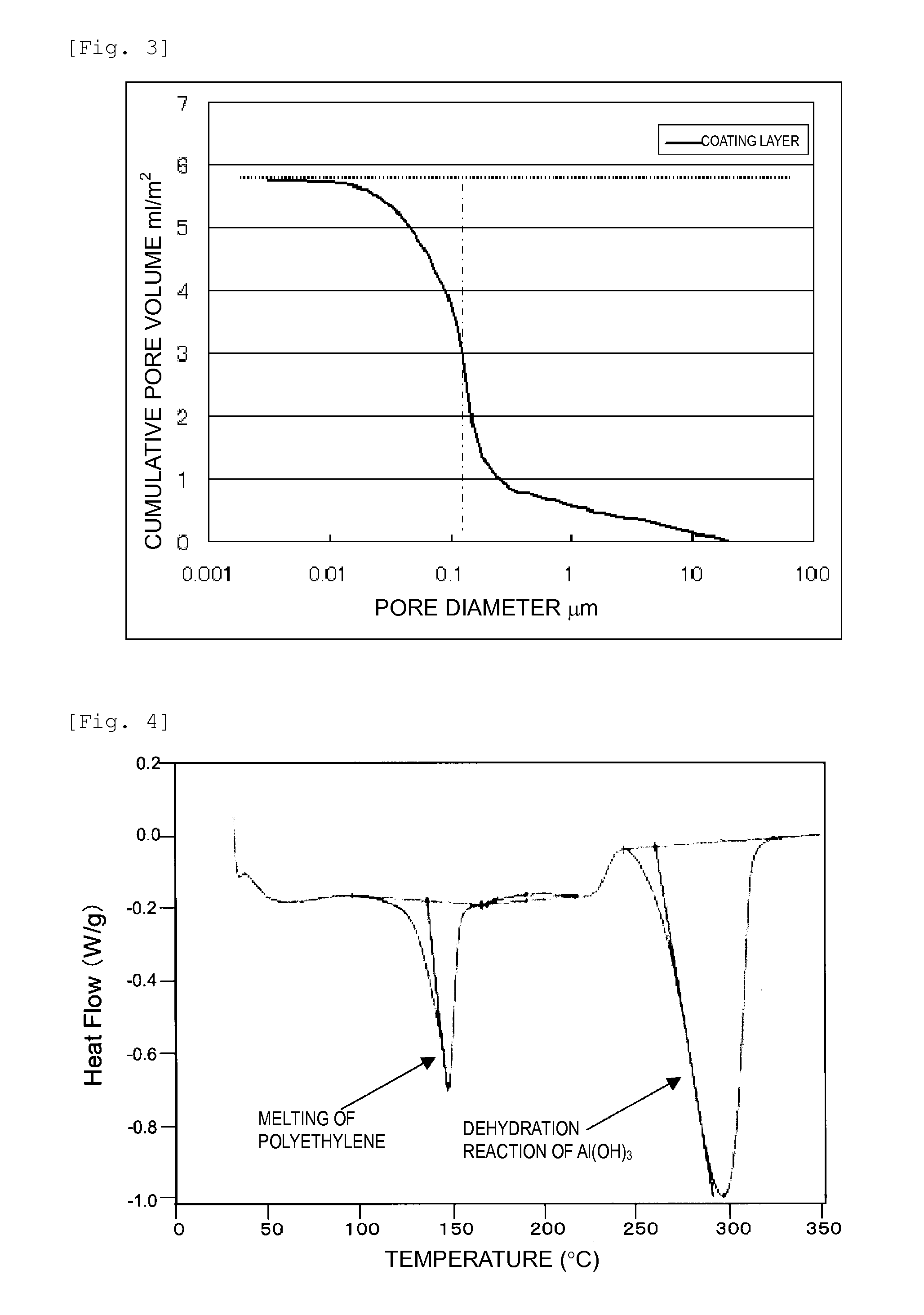Separator for nonaqueous secondary battery
a secondary battery and separation device technology, applied in the direction of electrical equipment, cell components, cell components, etc., can solve the problems of current cut-off function deterioration, battery heat runaway, microporous membrane per se melts and deforms, etc., to achieve excellent heat resistance, excellent ion permeation, and excellent heat resistance
- Summary
- Abstract
- Description
- Claims
- Application Information
AI Technical Summary
Benefits of technology
Problems solved by technology
Method used
Image
Examples
example 1-1
[0166]As polyethylene powder, GUR2126 (weight average molecular weight: 4,150,000; melting point: 141° C.) and GURX143 (weight average molecular weight: 560,000; melting point: 135° C.), each of which is manufactured by Ticona, were used. GUR2126 and GURX143 in a 1:9 ratio (weight ratio) were dissolved in a mixed solvent of liquid paraffin (manufactured by MATSUMURA OIL CO., LTD.; Small P-350P; boiling point: 480° C.) and decalin so that the polyethylene concentration became 30% by weight to prepare a polyethylene solution. The polyethylene solution has the formulation: polyethylene:liquid paraffin:decalin=30:45:25 (weight ratio). The polyethylene solution was extruded through a die at 148° C., and cooled in a water bath to prepare a gel-form tape (base tape). The base tape was dried at 60° C. for 8 minutes and at 95° C. for 15 minutes, and the resultant base tape was stretched by biaxial stretching in which longitudinal stretching and transverse stretching are successively conducte...
example 1-2
[0169]As polyethylene powder, GUR2126 (weight average molecular weight: 4,150,000; melting point: 141° C.) and GURX143 (weight average molecular weight: 560,000; melting point: 135° C.), each of which is manufactured by Ticona, were used. GUR2126 and GURX143 in a 2:8 ratio (weight ratio) were dissolved in a mixed solvent of liquid paraffin (manufactured by MATSUMURA OIL CO., LTD.; Smoil P-350P; boiling point: 480° C.) and decalin so that the polyethylene concentration became 30% by weight to prepare a polyethylene solution. The polyethylene solution has the formulation: polyethylene:liquid paraffin:decalin=30:68:2 (weight ratio). The polyethylene solution was extruded through a die at 148° C., and cooled in a water bath to prepare a gel-form tape (base tape). The base tape was dried at 60° C. for 8 minutes and at 95° C. for 15 minutes, and the resultant base tape was stretched by biaxial stretching in which longitudinal stretching and transverse stretching are successively conducted...
example 1-3
[0171]A separator for a nonaqueous secondary battery of the invention was obtained in substantially the same manner as in Example 1-1 except that magnesium hydroxide (manufactured by Kyowa Chemical Industry Co., Ltd.; KISUMA 5P) having an average particle size of 0.8 μm was used as an inorganic filler. In the separator, the coating weight of the heat-resistant porous layer on the both surfaces was 5.05 g / m2, and the porosity of the heat-resistant porous layer was 66%. The whole separator had a thickness of 20 μm, a porosity of 54%, and a penetration strength of 351 g.
PUM
 Login to View More
Login to View More Abstract
Description
Claims
Application Information
 Login to View More
Login to View More - R&D
- Intellectual Property
- Life Sciences
- Materials
- Tech Scout
- Unparalleled Data Quality
- Higher Quality Content
- 60% Fewer Hallucinations
Browse by: Latest US Patents, China's latest patents, Technical Efficacy Thesaurus, Application Domain, Technology Topic, Popular Technical Reports.
© 2025 PatSnap. All rights reserved.Legal|Privacy policy|Modern Slavery Act Transparency Statement|Sitemap|About US| Contact US: help@patsnap.com



